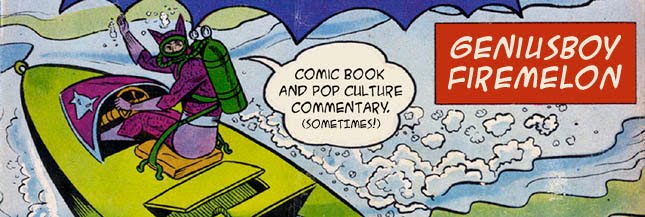 I didn't want to have to resort to citing Susan Sontag's over-referenced 1964 essay, "Notes on Camp," but I couldn't help but think of it as I read the latest issue of my most guilty pleasure: Salvation Run.
I didn't want to have to resort to citing Susan Sontag's over-referenced 1964 essay, "Notes on Camp," but I couldn't help but think of it as I read the latest issue of my most guilty pleasure: Salvation Run.I don't normally go for guilty pleasures. I love a lot of trashy, unreputable stuff, but I certainly don't feel guilty about any of it. But Salvation Run is the type of book even the original writer abandoned out of embarrassment. Bill Willingham might have used words like "over-extended" or "illness," but it was all code for "the book is such crap that I don't even want to cash that paycheck anymore."
Yet I'll tell you right now: I love Salvation Run. I know it's not good. I know Sean Chen can't draw a mouth that looks anything like even a cartoon version of an actual, human mouth. I know the book is an editorial mandate on a stick. I know all of that, and yet I love the abandoned little bastard. I love it so much that I dropped it after issue #2, saw issue #3 on the shelf, refused to buy it and, feeling regret, made a special trip to the comic shop a day later to purchase it after all.
This month, with Salvation Run #4, I embraced my guilty pleasure and read it on the day of release.
Which brings me to Susan Sontag. The word campy is bandied about more often than it's truly understood. Everyone says the Adam West Batman is campy, and the Power Rangers is campy, and the Rocky Horror Picture Show is campy, but camp isn't necessarily just bad special effects and people doing goofy stuff in costumes. Camp is a whole list of things. 58 things, if Sontag is to be believed.
So let's explore some of Sontag's 58 qualities of Camp, and I'll throw in my commentary on Salvation Run at corresponding moments:
1. To start very generally: Camp is a certain mode of aestheticism. It is one way of seeing the world as an aesthetic phenomenon. That way, the way of Camp, is not in terms of beauty, but in terms of the degree of artifice, of stylization. Sean Chen's "figure drawing" and "facial expressions" are certainly stylized, and not thinking in terms of beauty will put you in the right frame of mind for Salvation Run, definitely.
2. To emphasize style is to slight content, or to introduce an attitude which is neutral with respect to content. It goes without saying that the Camp sensibility is disengaged, depoliticized -- or at least apolitical. While Civil War might have been a political allegory about the price of freedom in the post-9/11 world, Salvation Run is about a bunch of dorky z-list super-villains split into two warring factions, led by the Joker and Lex Luthor, respectively. That's the extent of the thematic depth and political message. Lex Luthor's guys fight Joker's guys. Plus, some renegades smash some shit.
5. For Camp art is often decorative art, emphasizing texture, sensuous surface, and style at the expense of content. In Salvation Run #4, genius super-ape Gorilla Grodd BLUDGEONS GENIUS SUPER-APE MONSIEUR MALLAH WITH A BRAIN IN A JAR! That image on the cover is not a metaphor. Ape vs. ape. Many, many pages of Ape on Ape action with cranial catastrophe. That's probably the type of thing Sontag had in mind.
7. Nothing in nature can be campy . . . Rural Camp is still man-made, and most campy objects are urban. You know what else is campy? Hostile alien worlds populated by evil robot things that live underground. Hell yeah!
8. Camp is a vision of the world in terms of style -- but a particular kind of style. It is the love of the exaggerated, the "off," of things-being-what-they-are-not. The sycophantic boy CarnEVIL loves Joker so much, he wants to cut him into bits. That's what Sontag means by "off."
11. Camp is the triumph of the epicene style. Ape battles are nothing if not epicene.
23. In naïve, or pure, Camp, the essential element is seriousness, a seriousness that fails. Of course, not all seriousness that fails can be redeemed as Camp. Only that which has the proper mixture of the exaggerated, the fantastic, the passionate, and the naïve. Sounds like the tag line for the Salvation Run trade paperback. DC, are you listening?
36. But there are other creative sensibilities besides the seriousness (both tragic and comic) of high culture and of the high style of evaluating people. And one cheats oneself, as a human being, if one has respect only for the style of high culture, whatever else one may do or feel on the sly. No need to feel guilty about loving Salvation Run, says Sontag!
39. The excruciating is also one of the tonalities of Camp. I was going to keep going, but #39 just about sums it up. Salvation Run: excruciatingly AWESOME. Did I mention that the premise of the comic is Lord of the Flies with super-villains on an alien planet? The Joker plays the part of Jack, Lex Luthor is Ralph, and Mallah is, apparently, Piggy. Also, about 900 hundred other, poorly drawn, far more obscure DC villains populate the series. And they're all dumb, grumpy, and evil as hell.
I can't wait to see what happens next.

I don't belive in guilty pleasures: as I am awesome, it logically follows that if I like something it is therefore awesome. That physics, yo.
ReplyDeleteRight. That's how I feel too. Is that just arrogance or does it reach the level of hubris?
ReplyDeleteHa! Trick question! The answer is, "I don't care what anyone else thinks!"